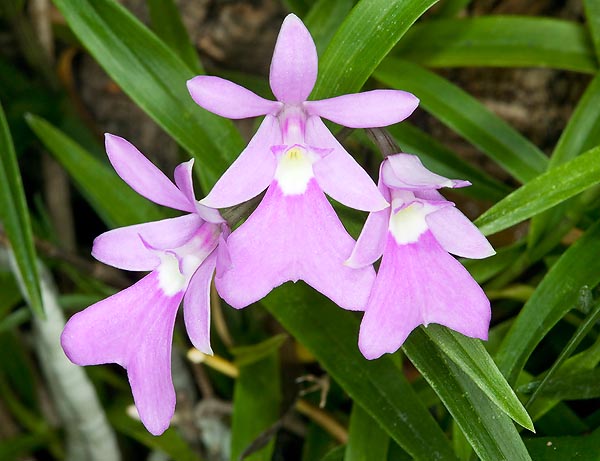Family : Orchidaceae

Text © Pietro Puccio

English translation by Mario Beltramini

Epidendrum centropetalum racemose inflorescences last even one month © Giuseppe Mazza
The name of the genus comes from the combination of the Greek terms “epi” = over and “déndron” = tree, with reference to the numerous species of the genus living on the trees; the name of the species probably comes from the combination of the Greek terms “kentron” = pointed and “petalon” = petal.
The Epidendrum centropetalum Rchb.f. (1852) is an epiphytic or terrestrial species
with thin, close together, stems, long up to about 75 cm, with alternate leaves,
distichous, oblong-linear, 3-8 cm long and 0,4-1,6 cm broad, which, with the time, tend to fall starting from the lowest ones, with warty foliar base wrapping the stem.
Racemose inflorescences, rarely ramified, at the apex of the stems, up to 10 cm long, carrying a variable number of small flowers of the diameter of about 2-2,5 cm, of colour mainly from dark pink to purple pink; long-lasting flowering, four weeks about, mostly between late winter and early summer.
Elliptic dorsal sepal, about 8 mm long and 3 mm broad, oblong lateral sepals with pointed apex, 8-10 mm long and 3 mm broad, oblanceolate petals, 7-9 mm long and 1-2,3 mm broad, and trilobed labellum, about 10 mm long and 8 mm broad, with deeply bilobed median lobe.
It reproduces by seed, in vitro by division and, easily, by means of the young plants forming at the nodes along the stem (in jargon “keiki”, which in Hawaiian means “sons”) that may be removed when they have formed a good rooting apparatus.
Species of easy cultivation for temperate-warm climate, it requires high humidity, 60-80%, filtered sunlight or slight shade, with lowest temperatures in winter which have never to get under 14-16 °C.
It does not require a precise resting period, only a reduction of the waterings after the flowering until the vegetative regrowth. It does not stand water stagnations at the roots, which must dry up completely between the waterings, therefore these ones are to be duly spaced, for such reason they are mounted preferably on bark or cork raft, with possible sphagnum at the base for keeping the humidity; if cultivated in a container, are to be chosen small pots with a much draining and aerated compost, this can be formed by medium-large sliced bark fragments and charcoal.
For the waterings and the nebulisations are to be utilized rain water, or water obtained by reverse osmosis or demineralised; the fertilizations, duly distributed in way to avoid salts accumulations, are to be done preferably with hydro-soluble balanced products, with microelements, at ¼ of the dosage suggested on the package. Repottings, transplants and divisions are to be done by the end of the flowering.
The species is inscribed into the appendix II of the CITES (species whose trade is internationally ruled).
Synonyms: Oerstedella centradenia Rchb.f. (1852); Oerstedella centropetala (Rchb.f.) Rchb.f. (1852); Epidendrum centradenia (Rchb.f.) Rchb.f. (1865); Epidendrum tenuiflorum Schltr. (1906); Epidendrum aberrans Schltr. (1918); Epidendrum leprosum Schltr. (1923); Oerstedella tenuiflora Hágsater (1981); Oerstedella aberrans (Schltr.) Hamer (1983).
→ For general notions about ORCHIDACEAE please click here.
